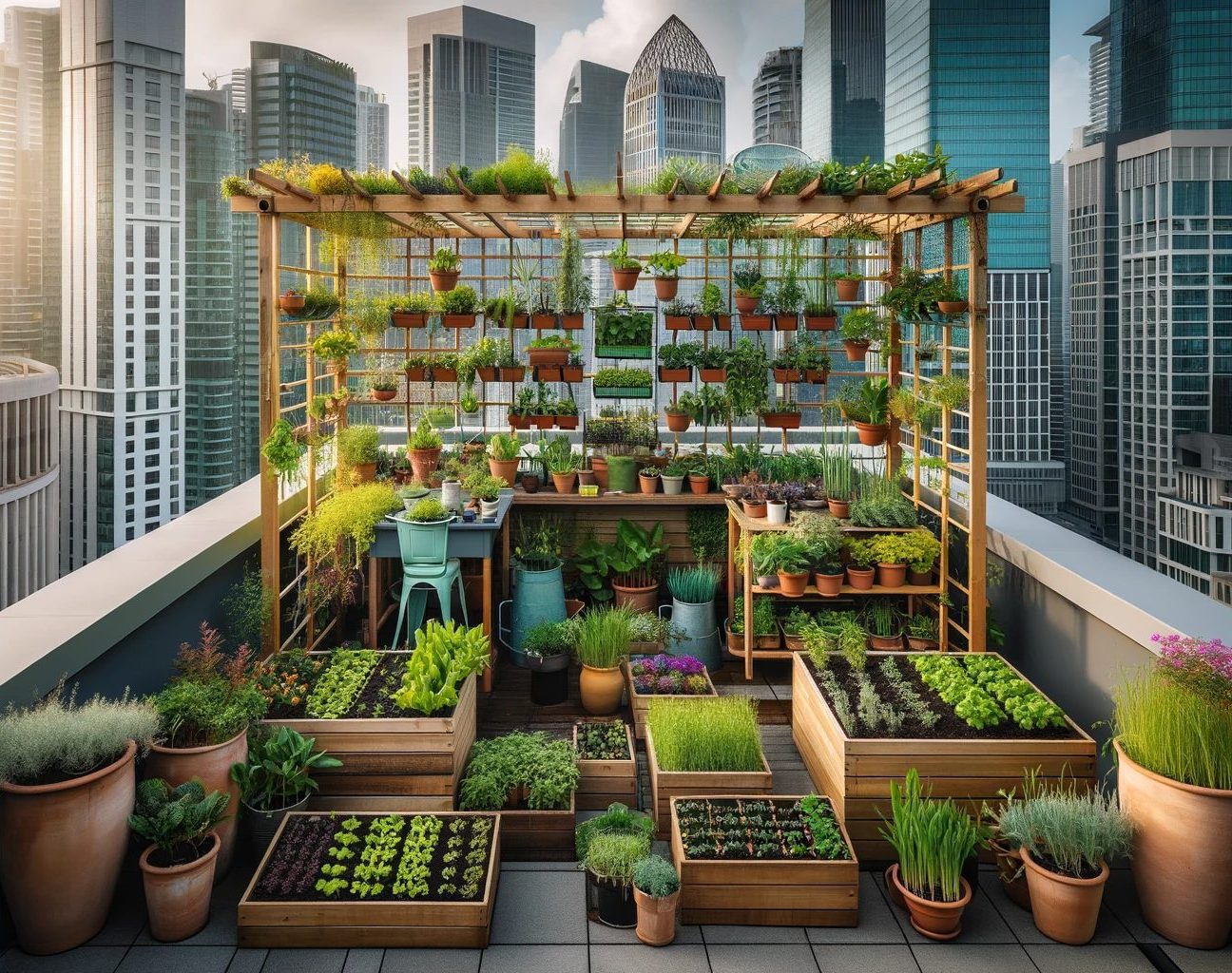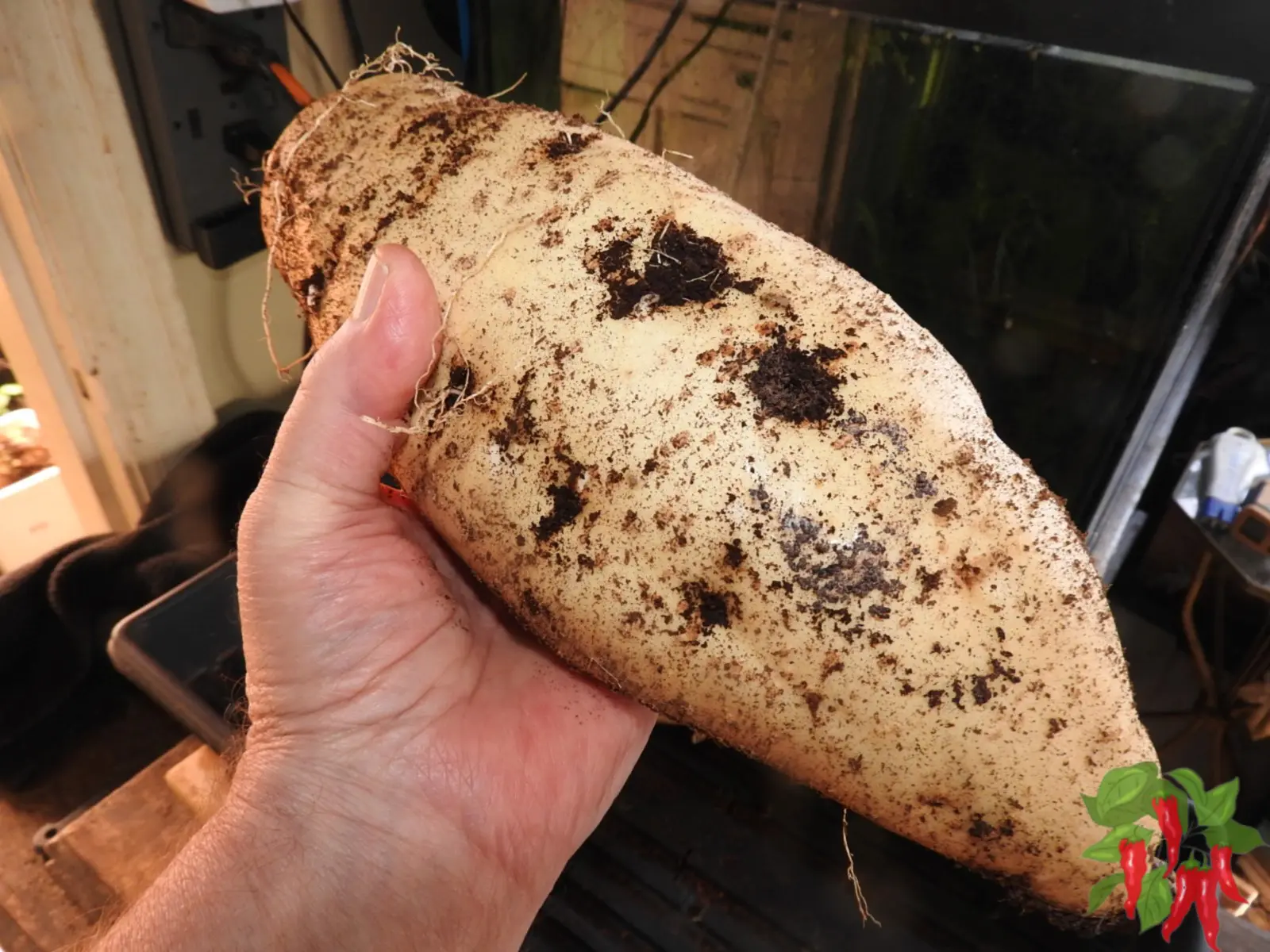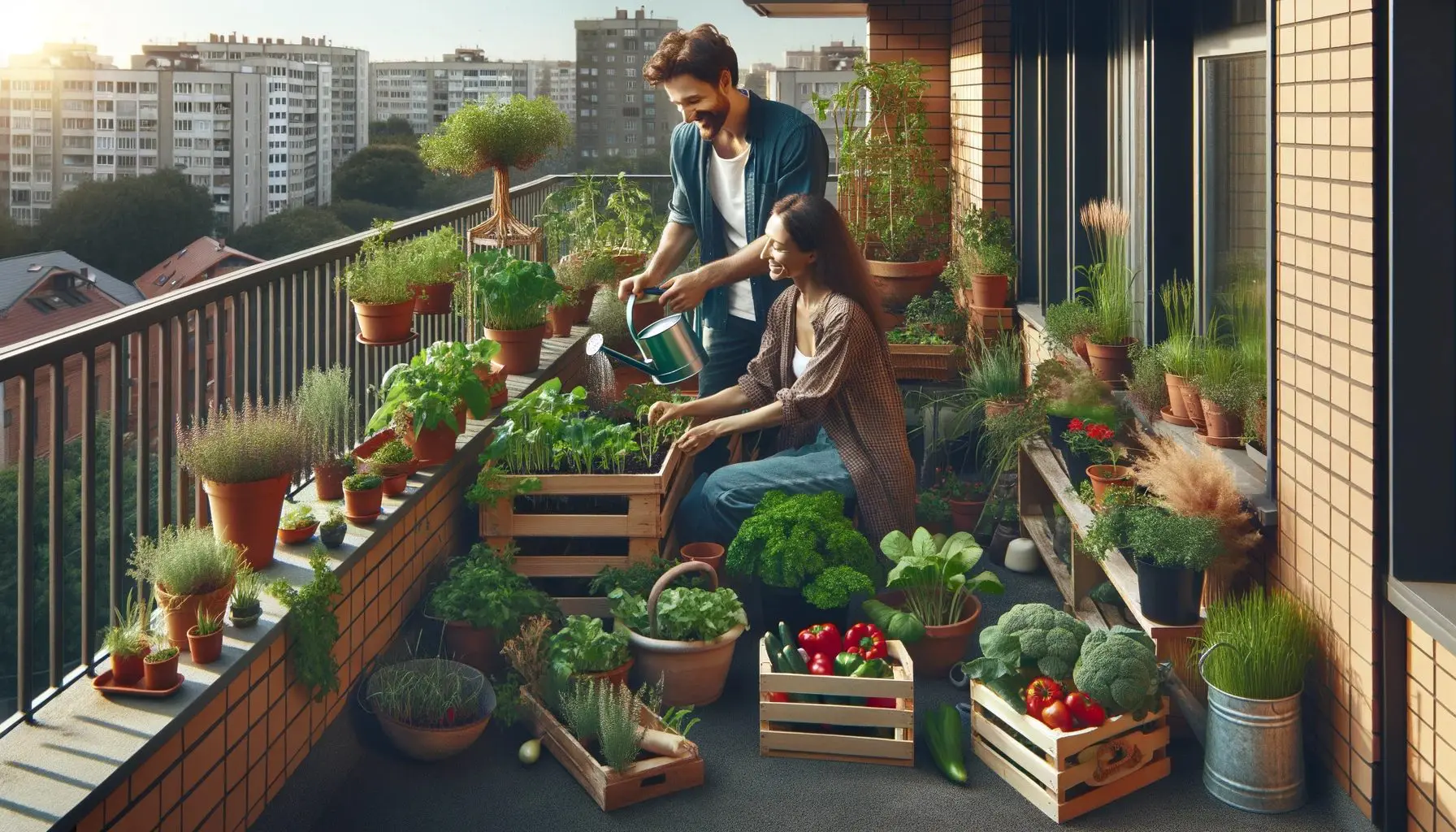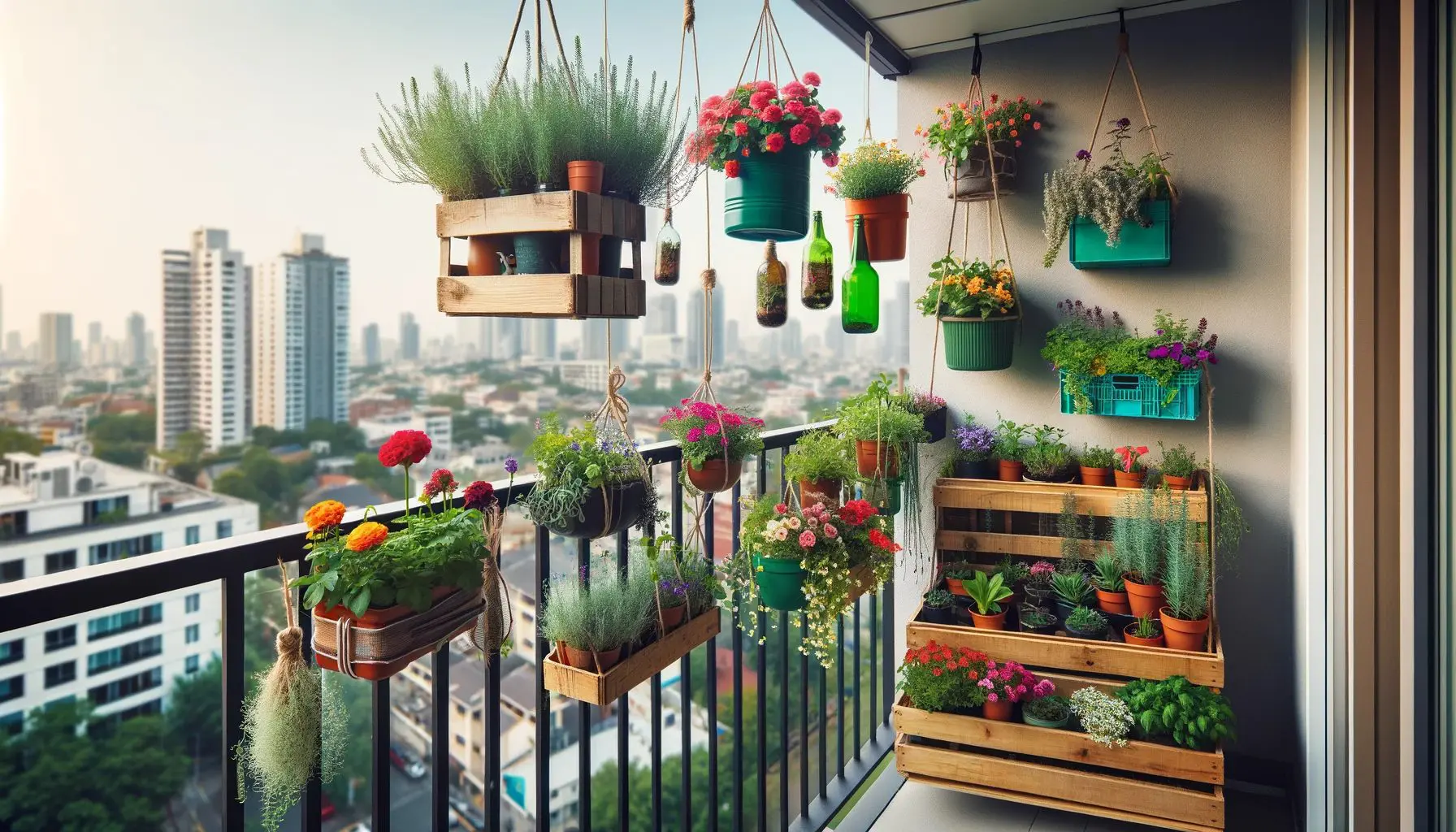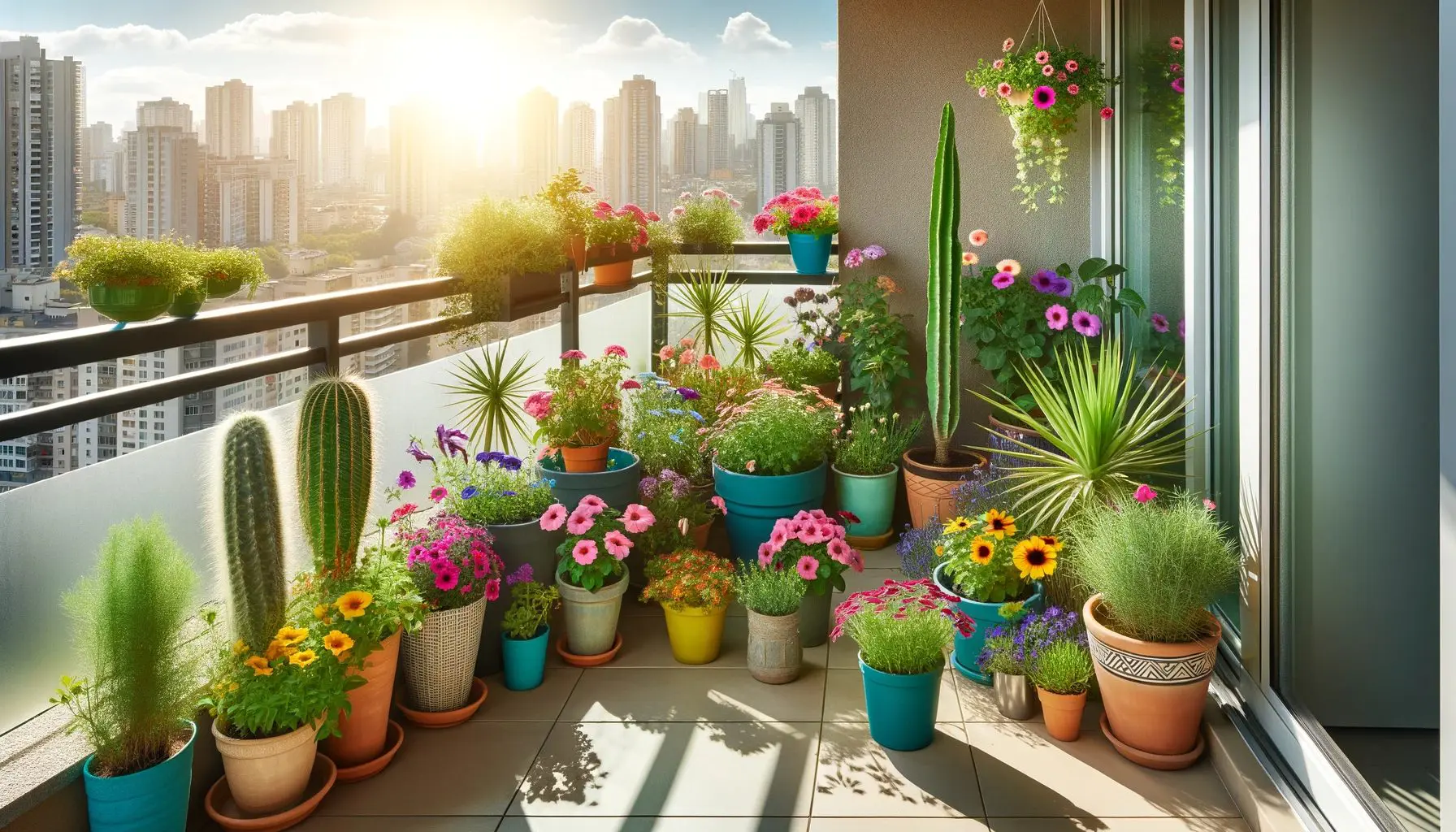This post contains affiliate links. If you buy something from one of our links we may earn a commission. Thanks
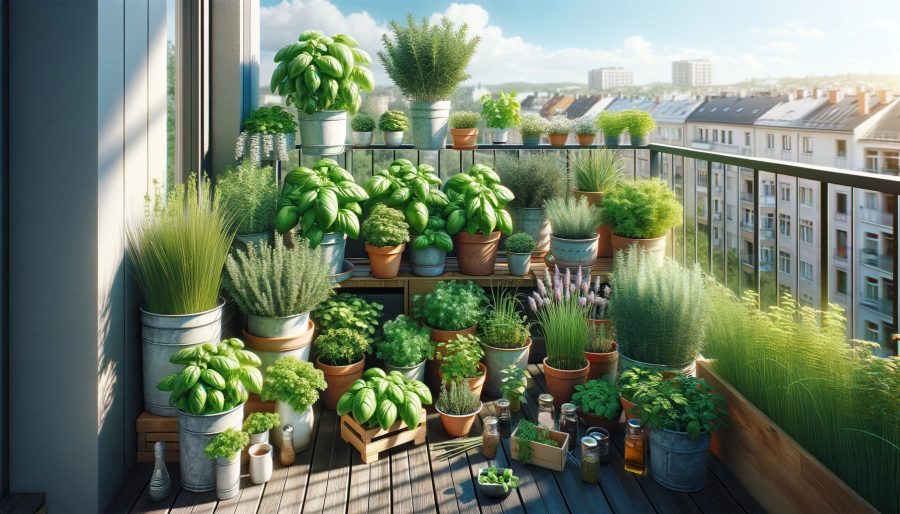
Dive into the joy of Balcony herb gardening! Discover easy tips and ideas for growing lush herbs in small spaces, perfect for adding fresh flavors to your urban home.
Balcony Herb Gardening Key Takeaways:
- Balcony herb gardening involves growing herbs in containers on balconies, utilizing limited space.
- It’s ideal for urban dwellers, allowing them to enjoy fresh, homegrown herbs for cooking and aromatic pleasure, despite having a small outdoor area.
Welcome to the world of Balcony herb gardening. It’s a delightful journey into growing your own lush, aromatic herbs right on your urban balcony.
Whether you’re a seasoned green thumb or a budding gardener, this guide will unveil the secrets to transforming your small space into a verdant, fragrant haven.
Introduction to Balcony Herb Gardening
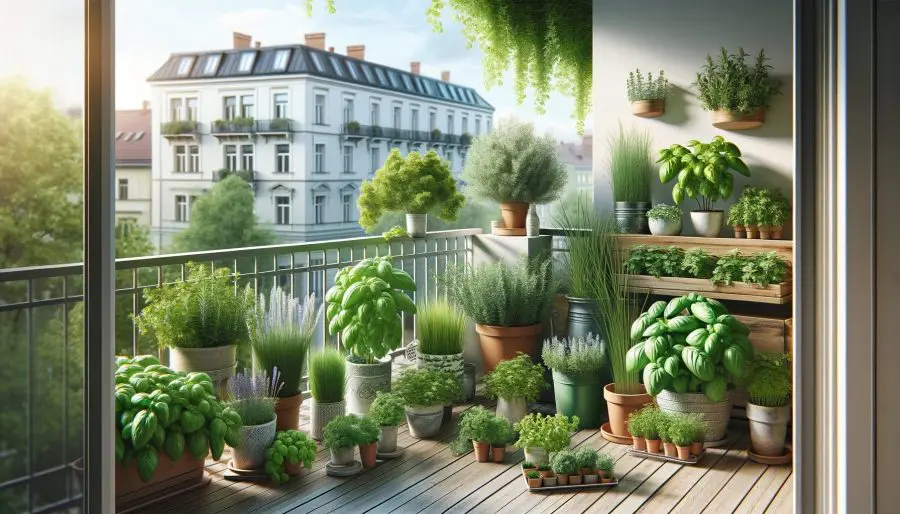
Balcony herb gardening is a delightful and enriching way to bring greenery and fresh flavors to your urban living space.
Whether you have a sprawling balcony or just a modest nook, growing herbs is both achievable and enjoyable.
This guide is your comprehensive companion, walking you through every step of creating a flourishing herb garden right on your balcony.
From understanding the basics of herb gardening to innovative balcony herb garden ideas, we’ve got you covered.
So, let’s embark on this green journey and transform your balcony into a haven of aromatic and culinary delights.
Key Takeaways Balcony Herb Gardening Guide:
- Balcony herb garden ideas: Learn to utilize even the smallest spaces for growing herbs.
- Apartment balcony herb garden ideas: Tailored tips for apartment dwellers to grow herbs.
- Small balcony herb garden ideas: Creative ways to maximize limited balcony space for herb gardening.
Herbs are easy to grow, with most preferring sun and fast-draining soil. Perennial herbs such as rosemary, sage and lavender look good in landscape plantings and should be low maintenance. Many herbs can be container-grown. WSU Extension
Understanding Your Balcony
Before you start planting, it’s crucial to assess your balcony’s environment.
The amount of sunlight, space available, and exposure to elements like wind and rain will significantly influence your herb gardening success.
Evaluating Sunlight and Space
- Importance of Sunlight: Most herbs, such as basil and thyme, thrive in full sun, requiring about 6-8 hours of direct sunlight. Observe your balcony over a few days to understand the sunlight patterns.
- Space Assessment: Consider the size of your balcony and how it can be efficiently utilized. Even small balconies can host a variety of herbs using vertical gardening techniques like wall-mounted planters or railing herb gardens.
Choosing the Ideal Spot
- Sheltered Areas: Protect your herbs from strong winds which can hinder the growth of delicate herbs like cilantro. Using windbreaks or positioning pots against a wall can offer protection.
- Temperature Considerations: Herbs have varying temperature tolerances. Mediterranean herbs like rosemary prefer warmer conditions, while others like parsley can tolerate cooler temperatures.
Selecting the Right Herbs
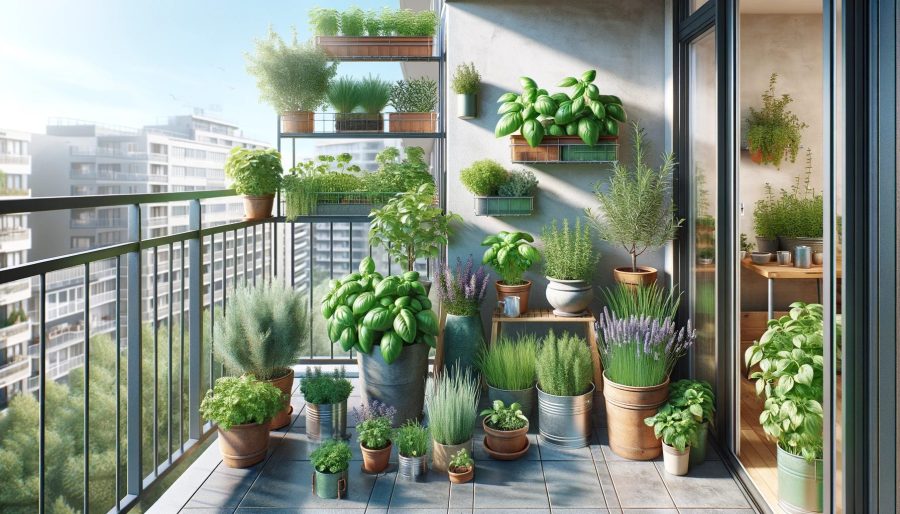
The choice of herbs is pivotal in balcony herb gardening. Whether it’s for culinary use or their aromatic presence, selecting the right herbs will enhance your gardening experience.
Your balcony herb garden brings with it the exciting task of selecting the right herbs.
This choice is more than just picking your favorites; it involves a careful consideration of your culinary tastes, the specific conditions of your balcony, and the growth habits of each herb.
Whether you’re a gourmet chef looking to add fresh flavors to your dishes or a novice gardener seeking to infuse your urban space with aromatic greenery, choosing the right herbs is crucial.
In this section, we’ll explore how to align your herb selection with your cooking preferences, understand the varying light and space requirements of different herbs, and consider the maintenance needs to ensure your balcony garden thrives.
From sun-loving rosemary to shade-tolerant mint, this guide will help you curate a selection of herbs that not only grow well in your unique balcony environment but also cater to your taste and lifestyle.
Culinary and Aromatic Preferences
- Culinary Herbs: If you’re a cooking enthusiast, consider herbs like basil for Italian dishes or cilantro for Asian cuisine.
- Aromatic Herbs: For a fragrant balcony, include herbs like lavender and rosemary which offer a pleasant scent and can also be used in DIY home projects.
Herb Varieties for Different Conditions
- Sun-Loving Herbs: Plants like oregano and sage need ample sunlight.
- Shade-Tolerant Herbs: In less sunny balconies, opt for herbs like mint or chives which can grow in partial shade.
Consideration of Growth Patterns
- Understanding Growth Habits: Some herbs like mint are invasive and should be planted separately to prevent them from overtaking other plants.
- Vertical and Compact Herbs: For limited spaces, herbs that grow vertically or remain compact, such as thyme and basil, are ideal choices.
Planting and Soil Preparation
A successful herb garden starts with proper soil preparation and the right planting techniques.
Diving into the world of balcony herb gardening, the next pivotal step is planting and soil preparation, the foundation of a thriving herb oasis.
This stage is all about creating the ideal environment for your chosen herbs to flourish.
The right soil mix and planting techniques can make a significant difference in the health and productivity of your herbs.
In this section, we delve into selecting the perfect soil, choosing containers that suit your balcony aesthetics and practical needs, and understanding the best practices for planting your herbs – whether from seedlings or seeds.
We will also cover the importance of drainage and why it’s crucial for preventing common issues like root rot.
With careful attention to these details, you can ensure that your balcony herb garden has the best possible start, setting the stage for lush growth and bountiful harvests.
Soil and Container Selection
Choosing the Right Soil: A well-draining potting mix is essential for herb growth.
Avoid garden soil as it compacts in containers and may contain pests or diseases.
Choose a high quality potting soil or use coco coir which is a more environmentally sustainable alternative.
Container Choices: Select containers based on their drainage capabilities, size, and aesthetic appeal.
Consider balcony herb garden kits or DIY options like repurposed bottles or pallets.
Make sure your containers have drainage holes to avoid root rot.
Planting Techniques
Seed vs. Seedling: the pros and cons of starting from seeds versus buying seedlings:
While seeds are usually cheaper they take longer. If you are new to gardening you might want to consider buying transplants.
Some herbs, like basil, can be easily grown from seeds, while others might be better off started as seedlings.
Planting Arrangement in Balcony Herb Gardens
An effective planting arrangement is key to maximizing the health and productivity of your balcony herb garden.
Thoughtful grouping and layout can not only ensure that each herb receives its necessary sunlight and water but also add to the aesthetic appeal of your space.
Here are some tips and ideas to consider when arranging your herb garden:
Understanding Sunlight and Water Needs
- Sun Requirements: Group herbs with similar sunlight needs together. For instance, Mediterranean herbs like basil, rosemary, and thyme thrive in full sun and can be placed in the sunniest part of your balcony.
- Watering Needs: Herbs like mint and parsley, which prefer consistently moist soil, should be grouped separately from drought-tolerant herbs like lavender and sage.
Layout Ideas for Balcony Herb Gardens
- Tiered Planters: Utilize tiered planters or shelves to create levels, allowing you to place sun-loving herbs on the top tier and those preferring shade below.
- Vertical Gardening: Consider a vertical garden for herbs with similar light preferences. This not only saves space but also makes a visually appealing green wall.
Companion Planting
- Complementary Pairings: Plant herbs that complement each other’s growth habits and needs. For example, basil and parsley both like moist soil and can be planted together.
- Avoiding Conflicts: Be aware of herbs that might not coexist well. For instance, mint is invasive and should be planted in its own container to prevent it from overtaking other plants.
Aesthetic and Practical Considerations
- Visual Appeal: Arrange herbs in a way that adds to the aesthetic value of your balcony. Consider the height, color, and texture of different herbs to create a visually pleasing arrangement.
- Accessibility: Place herbs that you use frequently, such as cilantro or chives, in easily accessible spots.
Utilizing Containers Effectively
- Container Size and Depth: Choose containers based on the root size of the herbs. Deeper pots are great for herbs with long roots like dill, while shallow pots can suffice for herbs like thyme.
- Grouping in Large Containers: In larger containers, create mini-herb gardens by planting herbs with similar needs together, ensuring there’s enough space for each to grow.
By considering these factors when arranging your balcony herb garden, you can create a beautiful, productive, and easy-to-maintain space that thrives throughout the growing season.
Care and Maintenance of Your Balcony Herb Garden
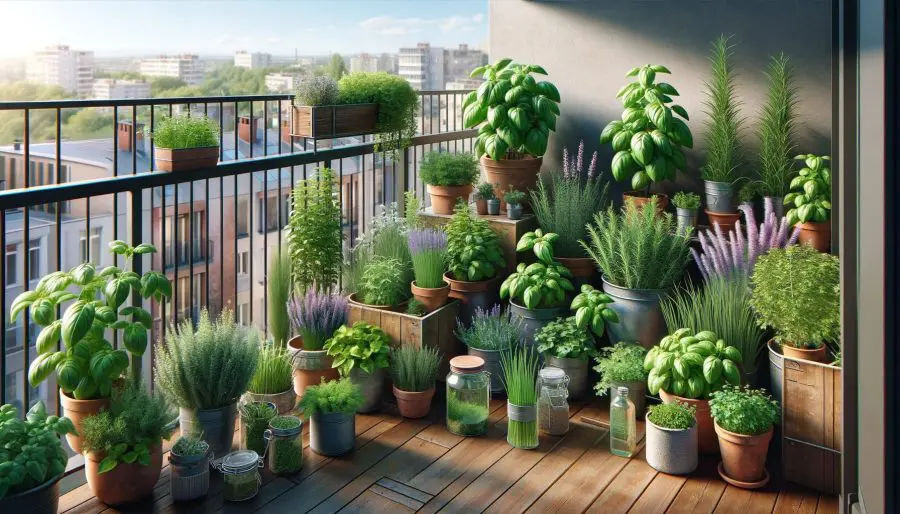
Proper care and maintenance are key to keeping your balcony herb garden healthy and productive. Here’s how you can ensure your herbs thrive:
After successfully setting up your balcony herb garden, the focus shifts to care and maintenance, the ongoing journey that ensures the health and vitality of your plants.
This essential phase of herb gardening encompasses understanding the nuances of watering, fertilizing, and general upkeep to keep your herbs flourishing.
In this section, we delve into the art of maintaining the perfect moisture balance for your herbs, the importance of regular, appropriate feeding, and the art of pruning for robust growth.
Here, you’ll learn how to tailor your care techniques to the unique needs of each herb and recognize the signs of both flourishing growth and potential issues.
From the refreshing moisture needs of mint to the sun-soaked resilience of rosemary, this guide will equip you with the knowledge to nurture a vibrant, productive balcony herb garden that can withstand the challenges of urban gardening.
Watering Your Herbs Right Watering Schedule for Herbs
- Soil Moisture Check: The key to a successful herb garden is maintaining the right soil moisture. Before watering, do the finger test. Insert your finger about an inch into the soil; if it feels dry, it’s time to water. If it’s still moist, wait a day or two.
- Frequency of Watering: The watering frequency depends on several factors:
- Weather Conditions: In hot, dry weather, your herbs may need daily watering. In cooler, cloudy conditions, they might need water only once or twice a week.
- Pot Size and Type: Smaller pots dry out faster and may require more frequent watering. Porous materials like terracotta also lose moisture quicker than plastic or glazed pots.
- Herb Types: Some herbs, like mint and basil, prefer more moisture, while others, like rosemary and thyme, prefer drier conditions.
Avoiding Overwatering and Preventing Root Rot
- Proper Drainage: Ensure all pots have adequate drainage holes to allow excess water to escape. This prevents water from pooling at the bottom, which can lead to root rot.
- Drainage Layer: Consider adding a layer of gravel or broken pottery pieces at the bottom of the pot before adding soil to enhance drainage.
- Watering Technique: When watering, do so slowly and evenly, allowing the water to soak into the soil without flooding the pot. Stop when you see water beginning to drain out of the bottom.
- Avoiding Wet Leaves: Try to water the soil directly, avoiding the leaves. Wet foliage can encourage fungal diseases.
- Monitoring for Overwatering Signs: Be vigilant for signs of overwatering, such as yellowing leaves or a musty smell coming from the soil, which could indicate root rot. If you notice these signs, reduce your watering frequency.
By following these guidelines, you can ensure your balcony herb garden receives the right amount of water, promoting healthy growth while avoiding common pitfalls like overwatering and root rot.
Feeding Your Herbs: Understanding Fertilizing Needs for Herbs
Herbs, in general, are not heavy feeders, but they do benefit from occasional fertilization to ensure robust growth. Over-fertilizing can harm herbs, leading to lush foliage but diminished flavor. The key is to strike a balance.
Organic Fertilization Options
- Compost Tea: A gentle, effective way to nourish herbs. It provides a wide range of nutrients and can be applied every 4-6 weeks during the growing season. To make compost tea, steep well-aged compost in water for several days, strain, and use the liquid to water your plants.
- Seaweed Extract: Rich in trace minerals and a natural source of potassium. Seaweed extract can be applied every 2-4 weeks. It’s particularly useful for herbs grown in containers as they have limited access to natural soil nutrients.
- Fish Emulsion: Another excellent organic option, providing a balanced mix of nitrogen, phosphorus, and potassium. Use it sparingly, every 4-6 weeks, as it’s quite potent.
Frequency of Fertilization
- Apply fertilizer every 4-6 weeks during the active growing season (spring and summer).
- Reduce fertilization in fall and winter, as herbs grow more slowly or go dormant.
Identifying and Addressing Nutrient Deficiencies
Herbs can show signs of nutrient deficiency, which can be addressed by adjusting your fertilization routine.
- Nitrogen Deficiency: Indicated by yellowing leaves, especially older leaves, and stunted growth. Apply a nitrogen-rich organic fertilizer, like fish emulsion, to remedy this.
- Phosphorus Deficiency: Look for dark green or purplish leaves and poor flower or root development. A seaweed extract with a balanced N-P-K (nitrogen-phosphorus-potassium) ratio can help.
- Potassium Deficiency: Symptoms include yellowing leaf edges and weak stems. Seaweed extract is also a good source of potassium.
By understanding the fertilizing needs of your herbs and recognizing signs of nutrient deficiencies, you can maintain a healthy, productive balcony herb garden.
Regular Pruning and Harvesting: Encouraging Growth Through Pruning and Harvesting in Balcony Herb Gardens
Encouraging Bushier Growth with Regular Pruning
Regular pruning is essential for maintaining the health and vigor of your balcony herb garden. Pruning encourages bushier growth and prevents herbs from becoming leggy and sparse.
- Timing: The best time to start pruning is when the plant has enough foliage to sustain growth, typically when it’s about 6-8 inches tall.
- Technique: Use clean, sharp scissors or pruning shears. Make your cuts just above a leaf node (the point where leaves grow from the stem). This encourages the plant to branch out from that point.
- Moderation: Prune regularly but moderately, removing only about one-third of the growth at a time. Over-pruning can stress the plant.
- Continuous Process: Make pruning a regular part of your herb garden maintenance. Regular trimming not only keeps the plants healthy but also provides you with a steady supply of fresh herbs.
Harvesting Tips for Optimal Growth and Flavor
Harvesting herbs is not just about getting fresh flavors for your kitchen; it’s also an important aspect of plant care.
- When to Harvest: The ideal time to harvest most herbs is just before they flower, as this is when their oils and flavors are most potent. Early morning is the best time for harvesting, after the dew has evaporated but before the sun is at its peak.
- How to Harvest:
- Leafy Herbs (like Basil and Mint): Snip off individual leaves or cut whole stems if necessary. Always cut above a leaf node or a set of leaves.
- Woody Herbs (like Rosemary and Thyme): Cut stems, but avoid cutting into the woody part of the plant that doesn’t produce new growth.
- Regular Harvesting: Regularly harvesting your herbs, especially leafy ones, can stimulate further growth and prevent them from becoming leggy.
- Avoid Over-Harvesting: Never harvest more than one-third of the plant at one time. This ensures the plant has enough foliage to continue growing healthily.
By incorporating regular pruning and proper harvesting techniques, you can ensure your herbs remain healthy, productive, and flavorful throughout the growing season.
Creative Balcony Herb Garden Ideas
Transforming your balcony into a flourishing herb garden is not just about planting and maintenance; it’s also an opportunity to unleash your creativity and style.
In this section, we explore innovative and aesthetically pleasing ideas to make your balcony herb garden not only a source of fresh herbs but also a focal point of beauty and relaxation in your home.
Whether you’re working with a compact space that calls for ingenious vertical solutions or a more spacious balcony that allows for elaborate arrangements, this guide offers a wealth of ideas.
From stylish DIY herb projects to functional yet decorative planting strategies, we will delve into how to blend functionality with personal expression.
Learn how to create a visually appealing herb haven that reflects your personality and transforms your balcony into an enchanting green retreat.
Designing Your Herb Garden: Aesthetic Considerations
Creating a visually appealing balcony herb garden involves more than just planting. The right design elements can transform your space into a lush, inviting retreat.
- Colorful Pots and Containers: Mismatched pots in various colors and sizes add a vibrant, eclectic look. Choose colors that complement your balcony’s color scheme or go bold with contrasting hues.
- Wooden Planter Boxes: Wooden boxes offer a rustic charm. They can be painted or stained to match your balcony décor and are perfect for growing groups of herbs.
- Vertical Gardening: Utilize vertical space with wall-mounted planters or trellises. This not only saves floor space but also creates an eye-catching living wall of herbs.
Practical Designs for Space Optimization
Balcony space is often limited, so maximizing every inch is crucial.
- Railing Planters: These planters are designed to fit over balcony railings, offering a smart way to grow herbs without taking up floor space.

- Hanging Baskets: Ideal for trailing herbs like thyme and oregano, hanging baskets can be suspended from the ceiling or wall brackets.
- Vertical Pallet Gardens: Upcycle wooden pallets into vertical gardens. They can be leaned against a wall or hung up to hold a variety of herbs in a compact space.
DIY Projects and Companion Planting
Incorporating DIY projects and companion planting can enhance both the utility and charm of your herb garden.
DIY Herb Projects
- Herbal Soaps and Candles: Use herbs like lavender and rosemary to create fragrant soaps and candles. These make for delightful homemade gifts or additions to your bathroom and living spaces.
- Smudge Sticks: Create your own smudge sticks using dried sage, rosemary, and lavender. These are used for aromatic purposes and can bring a calming scent to your home.
Companion Planting Benefits
- Pest Control: Planting certain herbs together can naturally repel pests. For example, planting basil near tomatoes can help repel flies and mosquitoes.
- Pollinator Attraction: Herbs like lavender and thyme attract bees and butterflies, promoting pollination in your garden.
- Space Maximization: Companion planting allows you to grow a variety of herbs in the same container, making efficient use of limited space.
By thoughtfully designing your balcony herb garden with both aesthetic and practical considerations, and engaging in creative DIY projects, you can create a functional and beautiful green space that reflects your personal style and maximizes your balcony’s potential.
FAQs: Balcony Herb Gardening
Navigating the world of balcony herb gardening can spark a lot of questions, especially if you’re just starting out.
To help you grow your green thumb, we’ve compiled a list of frequently asked questions.
These answers will guide you through common concerns and curiosities, ensuring your herb garden is not only a source of culinary delight but also a journey of learning and enjoyment.
Q. What herbs can you grow on a balcony?
A. Most herbs thrive on balconies, especially basil, mint, rosemary, and thyme. The key is understanding each herb’s light and space requirements.
Q. How do I start a herb garden on my balcony?
A. Begin by assessing your balcony’s sunlight exposure, choose appropriate herbs, prepare suitable soil and containers, and establish a regular care routine.
Q. What is the best layout for an herb garden?
A. The best layout depends on your balcony’s size and sunlight exposure. Utilize vertical space for small balconies and group herbs with similar sunlight and watering needs.
Q. Do herbs like full sun or shade?
A. While most herbs prefer full sun (6-8 hours of sunlight), some, like parsley and chives, can tolerate partial shade.
Q. How often should I water my herbs in pots outside?
A. Water when the top inch of soil feels dry, which may vary from daily in summer to weekly in cooler seasons.
Q. Can herbs get too much sun?
A. Yes, some herbs can get sunburnt in extremely hot conditions. It’s important to provide some shade during the hottest part of the day, especially for tender herbs.
Q. Can basil tolerate full sun?
A. Yes, basil thrives in full sun but needs regular watering to prevent drying out.
Embracing the Joys of Balcony Herb Gardening: Conclusion
As we wrap up our comprehensive guide to balcony herb gardening, it’s clear that this endeavor is more than just cultivating plants; it’s about nurturing a green space in the heart of the urban jungle.
Your balcony can transform into a lush, fragrant oasis, offering both culinary delights and a serene retreat.
The Rewarding Experience of Urban Gardening
- Culinary Adventures: Imagine the satisfaction of cooking with herbs plucked fresh from your balcony. Each herb adds a unique flavor and freshness to your dishes.
- Therapeutic Benefits: Beyond their culinary uses, these herbs offer a peaceful escape from the hustle and bustle of city life, contributing to mental well-being.
Sustainable Living and Green Spaces
- Eco-Friendly Practices: Balcony herb gardening is a step towards a more sustainable lifestyle, reducing your carbon footprint through homegrown produce.
- Creating Green Havens: In transforming balconies into verdant spaces, we contribute to urban biodiversity and beautification.
Continuous Learning and Growth
- Learning Journey: Gardening is a process of continuous learning and adaptation. Embrace the challenges and triumphs as you cultivate your green oasis.
- Community and Sharing: Share your experiences, harvests, and learnings with friends, family, and fellow gardening enthusiasts. Gardening often creates a sense of community and shared joy.
In conclusion, balcony herb gardening is a rewarding endeavor that enhances your living space, diet, and overall well-being.
Whether you’re a seasoned gardener or a curious beginner, the journey of growing herbs on your balcony promises a fulfilling and green adventure.
Happy gardening and may your balcony bloom with the flavors and fragrances of your favorite herbs!






